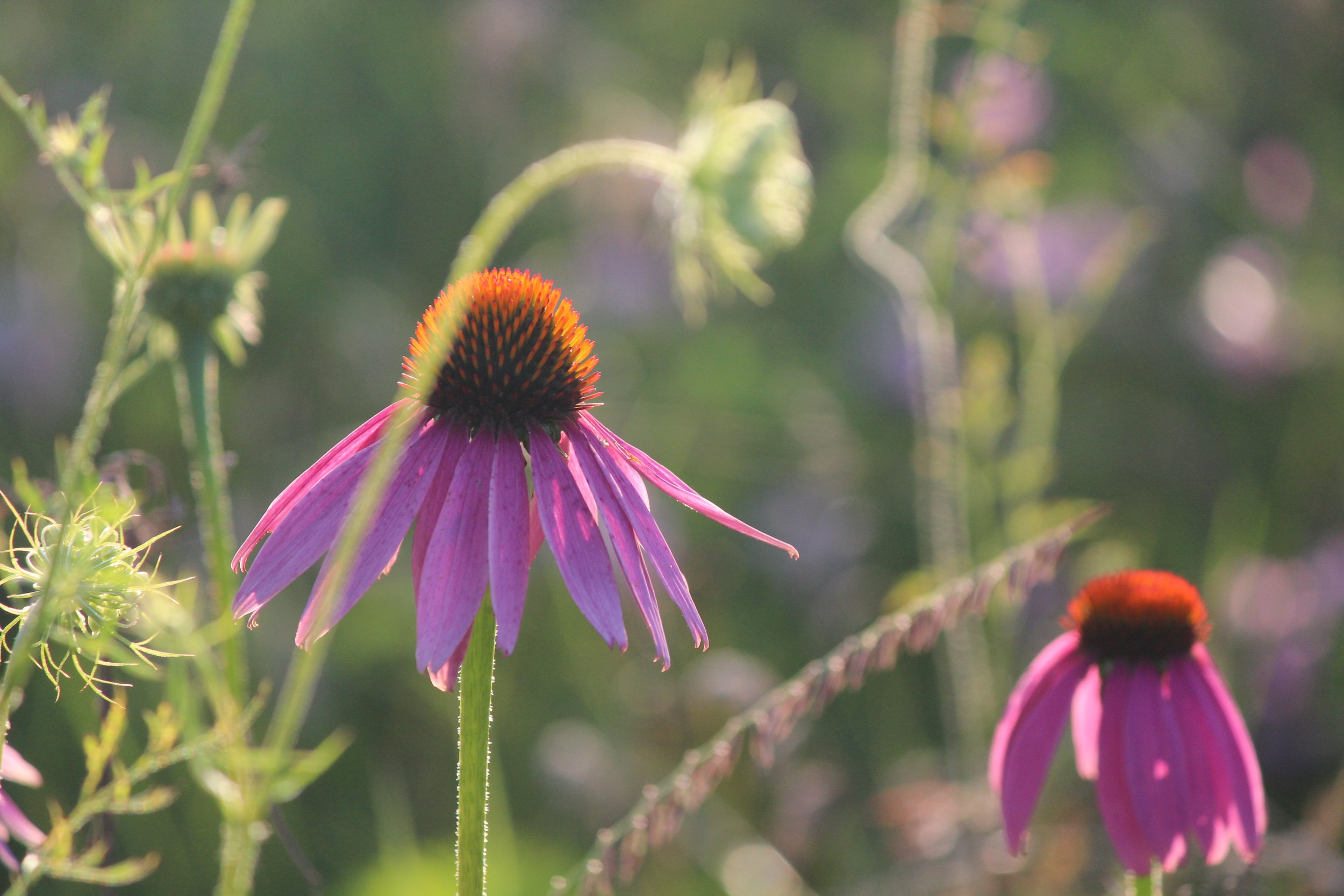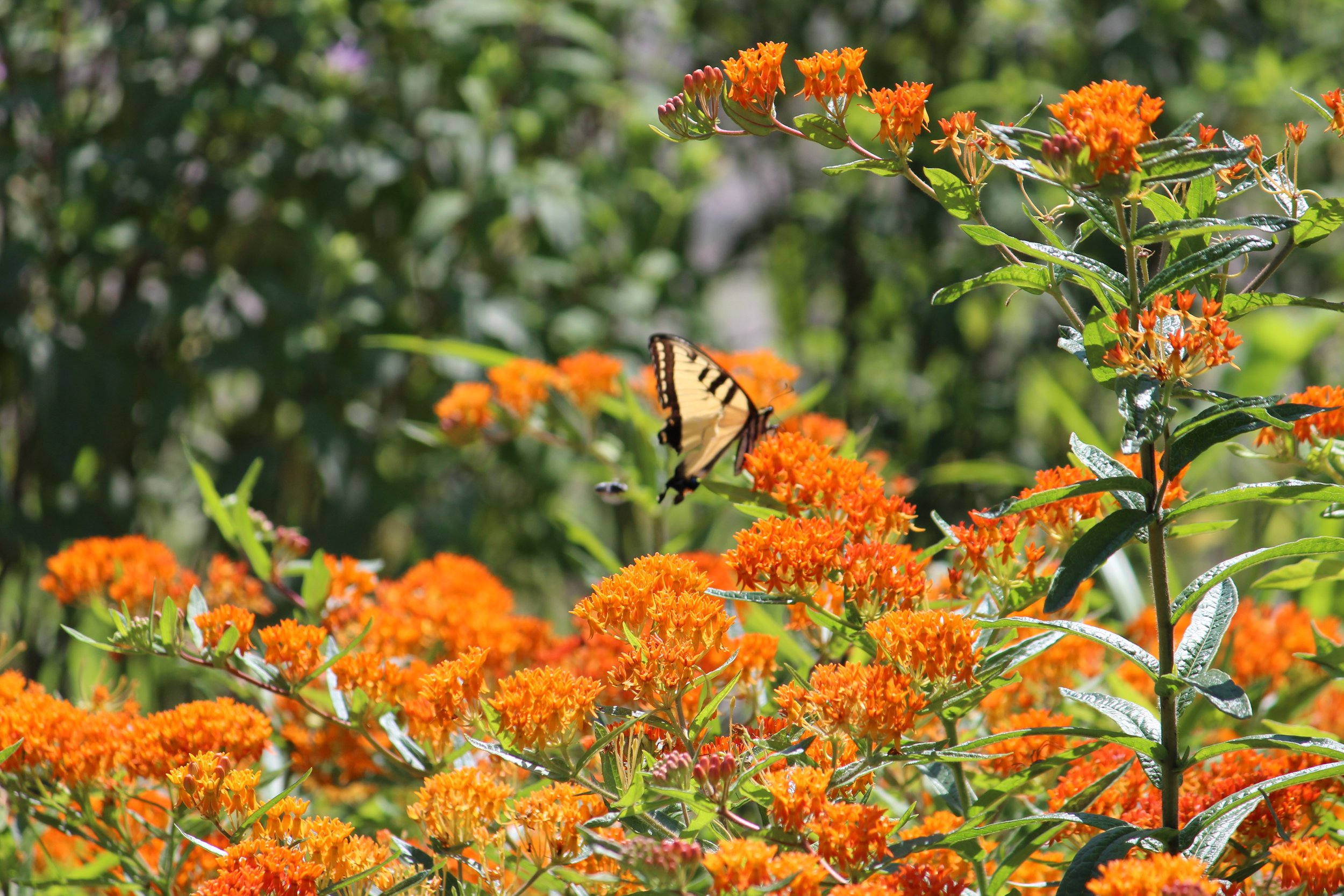
Native Plants
Native plants are indigenous to a given area and have evolved over thousands of years in a particular region, adapting to the geography, hydrology, and climate of that region.
A native plant is unique because it fully integrates itself into an ecosystem, establishing complex relationships with other local plants and animals. These plants form communities and biological interactions with specific flora, fauna, fungi, and other organisms. In other words, these plant communities depend on the organisms which evolved to survive while these local organisms also depend on the same native plants to live.
MICHIGAN NATIVE PLANTS
Michigan’s native plants have adapted to all of Michigan’s soil types - as well as woodlands, wetlands, ponds, streams, meadows, prairies, and everything in between.
Coming in a wide variety of shapes, colors, sizes, and foliage types, there are over 600 Michigan native plants including wildflowers, grasses, ferns, trees, groundcovers, shrubs, evergreens, and vines.
Some species of Michigan’s native plants have root systems that extend up to 15 feet or more underground. This characteristic not only allows the plant to be more successful at searching out water, but it also allows them to hold soil particles in place, preventing erosion and stormwater damage.
Most native species are perennial or self-seeding biennial plants. This means that they will typically re-seed themselves and continue to thrive and multiply with little human intervention. This also helps save costs by eliminating the need to buy new plants each year.
BENEFITS
Natural habitat
Soil stability
Erosion control
Climate resilience
Ecological enrichment
Stormwater filtration
Low maintenance landscaping

WHY FOCUS ON PLANTS?
Our front yards, side yards, backyards, schools, parks, commercial properties, utility easements, driveways, and parking lots are the frontlines to bridging the gaps between natural landscapes and densely populated areas.
The Detroit Urban Area is the 11th most-populated urban area in the United States. Today, 95% of the land in the Clinton River Watershed has been plowed, paved, cut down, or replaced with turfgrass – removing and changing the ecosystems that stabilize our lakes, rivers, streams, and wildlife.
With a fresh approach and some thoughtful planning, our landscaping plants can not only show year-round curb appeal but also be multifunctional by cleaning stormwater while providing for pollinators, beneficial insects, songbirds, and other wildlife.
Planning for Native Plants
PREPARING TO PLANT
ASSESS THE SITE - Identify the sun/shade requirements, moisture levels, and soil type.
SET GOALS - Review the type of habitat, purpose, and timeframe you envision.
ESTABLISH A BUDGET - Include soil amendments, plants, and labor. Gardens generally range from around $3-$30 per square foot.
SOIL TESTING (optional) - MSU extension analyzes soil for $25.
MAKE A DRAWING - Measure the estimated square footage of your garden, sketch the layout, and draw to scale.
MAKE A PLANT LIST - Calculate # of plants needed based on the scale drawing. Typically, around 1 plant per square foot is recommended.
MAINTENANCE
Native plants require very little care once established, much less than traditional gardens.
WATERING - Until the plants grow to full size, water is needed daily. This is the most important step to protect native plants as they grow
MULCHING - Adding this layer of protection above the soil will help control weeds and retain moisture until the plants mature.
WEEDING – Like any garden, weeding is a good idea to maintain the long-term health of the plants.
Popular Species for Gardens
-
Black-eyed Susan
Black-Eyed Susan, Rudbeckia hirta, stands at a height of 1 to 3 feet and blooms in radiant yellow from August to September. Flourishing in dry to moderate water conditions, it adapts well to both full and partial sunlight.
This plant attracts a variety of pollinators, including flies, wasps, and even the Powesheik Skipperling! Noteworthy as a biennial, it demonstrates high drought tolerance, making it a resilient choice for gardens in need of low-maintenance and vibrant blooms.
-
Butterfly Weed
Butterfly Weed, Asclepias tuberosa, reaches a height of 2 to 3 feet and showcases vibrant orange blooms from July to August. Thriving in dry to moderate water conditions, it adapts well to full or partial sunlight.
This plant attracts bees and butterflies for pollination and has the advantage of being easily propagated from seeds if planted in autumn. Additionally, it serves as a natural deterrent for deer, making it a valuable addition to gardens seeking wildlife-friendly options.
-

Canada Anemone
Canada Anemone, scientifically named Anemone canadensis, grows between 1 to 2 feet tall and showcases white blooms from May to July. It thrives in medium to wet conditions, adapting well to full or partial sunlight.
This plant attracts bees for pollination, but it's important to note its aggressive spreading nature. It can quickly fill in an area due to its rapid growth.
Photo Source: U.S. FOREST SERVICE - Christopher David Benda
-

Cardinal Flower
The Cardinal Flower, scientifically known as Lobelia cardinalis, stands tall at heights ranging from 2 to 6 feet. It boasts striking red blooms that adorn the landscape from July through October. Thriving in medium to wet conditions, it flourishes in both full and partial sunlight.
This plant is a favorite among hummingbirds and butterflies for pollination. However, like its cousin, the Great Blue Lobelia, it's sensitive to salt and cannot tolerate road runoff.
-

Columbine
Columbine, Aquilegia canadensis, grows between 2 to 3 feet tall and blooms in a vivid red hue from May to July. Thriving in moderate water conditions, it adapts well to various light settings, from full sun to partial shade.
This plant is a favorite among hummingbirds for pollination and serves as a natural deterrent for deer. It flourishes best in partial shade, making it a charming addition to shaded areas in gardens.
-

Common Boneset
Common Boneset, Eupatorium perfoliatum, stands tall at 4 to 6 feet and blooms in white from August to October. It thrives in medium to wet conditions and adapts well to various soil types, including sandy and clay soils, making it quite versatile.
This plant attracts bees for pollination and demonstrates resilience, tolerating both full and partial sunlight.
-

Common Milkweed
Common Milkweed, Asclepias syriaca, grows to a height of 3 to 5 feet and blooms in a soft pink hue from June through September. It thrives in medium to wet conditions and can adapt to both full and partial sunlight.
This plant attracts bees and butterflies for pollination and boasts deep roots, making it an excellent choice for creating a monarch way station, providing essential support for these amazing butterflies.
-

Great Blue Lobelia
The Great Blue Lobelia, or Lobelia siphilitica, grows between 1 to 4 feet tall and blooms in shades of blue from July to September. It prefers medium to wet conditions, needing moderate to high water levels, and can thrive in full or partial sunlight.
This plant attracts hummingbirds and bees but is sensitive to salt and cannot tolerate road runoff.
Photo Source: Michigan State University - Native Plants and Ecosystem Services
-
Purple Coneflower
The Purple Coneflower, Echinacea purpurea, grows to heights between 2 to 5 feet and showcases its vibrant purple blooms from June to August. Thriving in dry to moderate water conditions, it adapts well to both full and partial sunlight.
This plant attracts a variety of pollinators, including bees, butterflies, and more. Renowned for its medicinal properties, it's a valuable addition to gardens. Additionally, it's naturally resistant to deer, making it an excellent choice for wildlife-friendly landscapes.
-

Rough Blazing Star
Rough Blazing Star, Liatris aspera, reaches heights of 2 to 5 feet and blossoms in a striking purple hue from August to September. Flourishing in dry to moderate water conditions, it adapts well to full or partial sunlight.
This plant attracts bees and butterflies for pollination and boasts drought tolerance. Its adaptability makes it an excellent choice for rain gardens with quick-draining soil, adding a burst of vibrant color to these landscapes.
-
Wild Bergamot
Wild Bergamot, also known as Bee Balm or Monarda fistulosa, stands at a height of 2 to 4 feet and blooms in a charming purple shade from June to September. Thriving in dry to moderate water conditions, it adapts well to both full and partial sunlight.
This aromatic plant is a magnet for various pollinators, including bees, butterflies, hummingbirds, and even the intriguing hummingbird moth. However, it's worth noting that its growth can be quite vigorous, sometimes spreading aggressively in garden settings.
GARDENS, LAWNS, & LANDSCAPING
-
Aside from fume-spewing lawnmowers, homeowners and gardeners have attempted to “green up” their lawns with multiple applications of fertilizers and pesticides, harming everything they touch – from the soil to the pollinators to the humans and their pets to the streams and rivers.
Because turfgrass has an average root depth of 2-6 inches, most of its water absorption occurs near the soil surface. These short root systems make lawns more susceptible to not only weeds but also drought and discoloration, so homeowners and businesses alike have invested extra time and expense into the watering of lawn and sprinkler systems
-
Lawns cover over 65,000 square miles of land in the United States
Lawns are the largest cultivated crop, exceeding that of corn or soybeans
Lawns consume 30,000 tons of pesticides every year, many being possible carcinogens
800 million gallons of gasoline propel lawnmowers each year
30% of municipal water supplies are used to water lawns each year
There are entire industries dependent on the fertilization, weeding, and feeding of lawns, and due to consumer demand, the agrochemical and agricultural biotechnology corporations continue to develop genetically modified grasses and more potent herbicides, even as weed-killing chemicals continue to be found in common U.S. food and beverage items.
As we’ve attempted to pursue lawns that look like they have been meticulously groomed by a dedicated team of golf course caretakers, we’ve applied and coated our lawns in fertilizers, insecticides, fungicides, and herbicides. Now that there has been a visible loss of wildlife and notable stormwater damage to our streams and rivers, many are seeking long-term solutions.
-
Nationwide, there are new, uniquely-American garden designs and lawn alternatives that are being cultivated by gardeners, landscape architects, homeowners and urban communities alike.
Sustainable landscape designs are now being incorporated into rain gardens, natural shorelines, native perennial beds and contemporary meadow gardens that are not only beautiful but functional and productive.
New lawn alternatives for no-mow lawns and eco-lawns now include dozens of options including mat-forming fescue grass and buffalo grass or ground covers like white clover or goldmoss sedum.
Landscapes for businesses, homes, and parks can now be functional, sustainable, and beautiful by incorporating native plants that support wildlife, serve as a genetic reservoir for diversity, prevent soil loss, and reduce stormwater runoff.
-
For decades, Americans have tried to emulate the perfectly manicured lawns of ancient English estates on the other side of the Atlantic. Now, we’re beginning to see and understand that the ideal “American Lawn” is not sustainable or healthy.
WATERFRONT PROPERTIES
-
A riparian buffer or a stream buffer is an area of land maintained in permanent vegetation that is not mowed. With the decline of many aquatic ecosystems due to development, riparian buffers have become a common conservation practice aimed at increasing water quality and reducing pollution.
A riparian buffer or a stream buffer is an area of land maintained in permanent vegetation. This “buffer strip” along streams, rivers, and lakes helps control air, soil, and water quality.
HOW DOES A RIPARIAN BUFFER WORK?
Riparian buffers trap sediment and enhance the filtration of nutrients and pesticides by slowing down runoff that could enter the local surface waters. The root systems of the planted vegetation in these buffers hold soil particles together which alleviate the soil from wind erosion, and stormwater surges and stabilize stream banks by providing protection against erosion and landslides.
Riparian Buffers can have several different configurations of vegetation varying from simply native grasses to combinations of native grasses, wildflowers, trees, and shrubs. Areas with diverse vegetation provide more protection from nutrient and pesticide flow, and at the same time, provide improved biodiversity amongst plants and animals.
-
Shoreline erosion is one of the most common problems that lakeshore property owners experience and large amounts of human activities can accelerate the natural erosion process.
Shoreline erosion is a problem for the property owner, the lake, and the entire lake community because sedimentation from erosion changes the entire lake ecosystem. For example, erosion and the intentional removal of water plants limit the feeding and spawning areas for fish and cause the water to become turbid and cloudy by the lack of roots holding soil in place.
In an attempt to protect shorelines and provide wave protection, previous lake and stream communities removed vegetation from the shoreline and added seawalls accompanied by shallow-rooted turfgrass. Unfortunately, these conventional practices have resulted in over 40% of Michigan’s inland lakes having poor shoreline habitat and eroding water quality.
UNDERSTANDING EROSION AT THE SHORELINE
Over time, shorelines change naturally due to seasonal water level changes, waves, and ice movement. This perpetual motion grinds and displaces soil particles which end up in the lake. In natural conditions, this is a very slow process over a long period of time.
An eroding shoreline can be the result of natural or human elements, can be site-specific or widespread, and may have more than one cause. In addition, the causes of shoreline erosion may differ because of a property's location on the lake, water level changes, and season.
-
In the wild, lawns are not naturally occurring on lakeshores for many reasons. Unlike turfgrass which has an average root depth of 2-6 inches, the root systems of native plants extend to a foot or more.
Native plants on a lake edge or river can live at or below the water level, and their densely interwoven root systems are required to physically stabilize a shoreline. These plants have strong roots that are specially designed to withstand waves, hold the soil in place, and thrive through all the climatic conditions of the region.
Aside from attracting geese who like to graze, turfgrass escalates the erosion of shorelines over time because their short root systems cannot withstand the energy of hitting waves, ice movement, or stormwater runoff.
-
Seawalls are hard-surfaced barriers installed along the shore with the intention of blocking waves, and they can be made from concrete, steel, wood, and rock-filled structures.
When shoreline erosion becomes an issue, property owners may choose a seawall because of the wave-flanking domino effect (i.e. multiple neighbors who already have seawalls installed) or because a seawall may be perceived as the only viable option.
SEAWALLS CAN’T STOP WAVES
As a wave hits a seawall, it is not absorbed by the hard surface area. Instead, the energy from the wave is directed downwards and sideways. This abrasive energy irritates and scours the lake bottom, removing sediment such as sand a gravel and scooping out deep holes.
As the wave energy is deflected sideways, wave flanking causes erosion to both sides of the neighboring properties. Where there might not have been any erosion to begin with, now there is a domino effect of seawall installations around the lake.
Scour and wave flanking can affect the lake size, wave height, and water quality, causing the lake to become deeper in front of a seawall in comparison to a nearby property without a hard-surfaced barrier. Over time, scouring will go deep enough to undercut the bottom of a seawall, causing a wall failure.
-
There are many different options and combinations of options for shoreline erosion control techniques and products that are used in protecting shorelines. The main ingredient in all of the more natural solutions is native plants. To learn more about seawall solutions and natural shoreline options, please visit Michigan Natural Shoreline Partnership.





